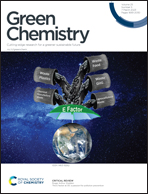Metal hydroxide assisted integrated direct air capture and conversion to methane with Ni/Al2O3 catalysts†
Abstract
Methods to synthesize sustainable and renewable methane are becoming of growing interest to relieve humankind from its reliance on fossil and finite natural gas reserves. Metal hydroxide salts are able to capture CO2 from dilute sources including ambient air in the form of carbonate and bicarbonate salts. We report herein the direct conversion of such inorganic carbonate salts into methane in yields of up to 100% utilizing both Ni/Al2O3 and Ni/CaAl2O4 catalysts. This conversion is achieved in 48 hours with 50 bar of hydrogen at a relatively moderate temperature of 225 °C under batch conditions. Water was also shown to improve the conversion of the carbonate salt to methane and the Ni/Al2O3 catalyst retained 99% of its activity in the alkaline media after five consecutive hydrogenation cycles. Remarkably, the metal hydroxide was also regenerated during the reaction and was reused to capture CO2 for subsequent reactions. Compared to the conventional sequential approach involving the capture of CO2 followed by the release of CO2 and its hydrogenation to methane in the Sabatier reaction, the integrated route presented here can offer a number of energetic and economic benefits that could pave the way for a robust carbon capture and conversion process.



 Please wait while we load your content...
Please wait while we load your content...
